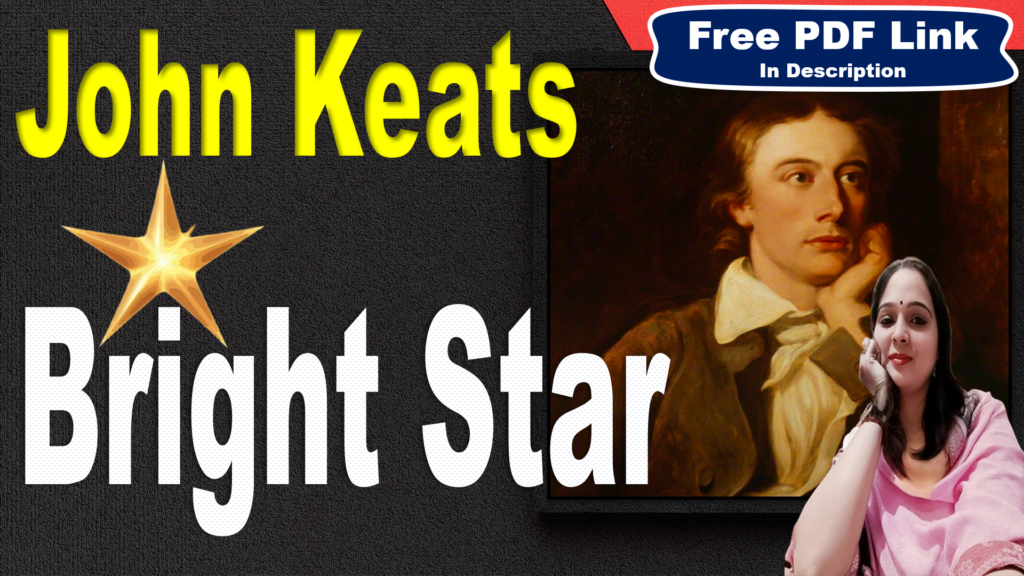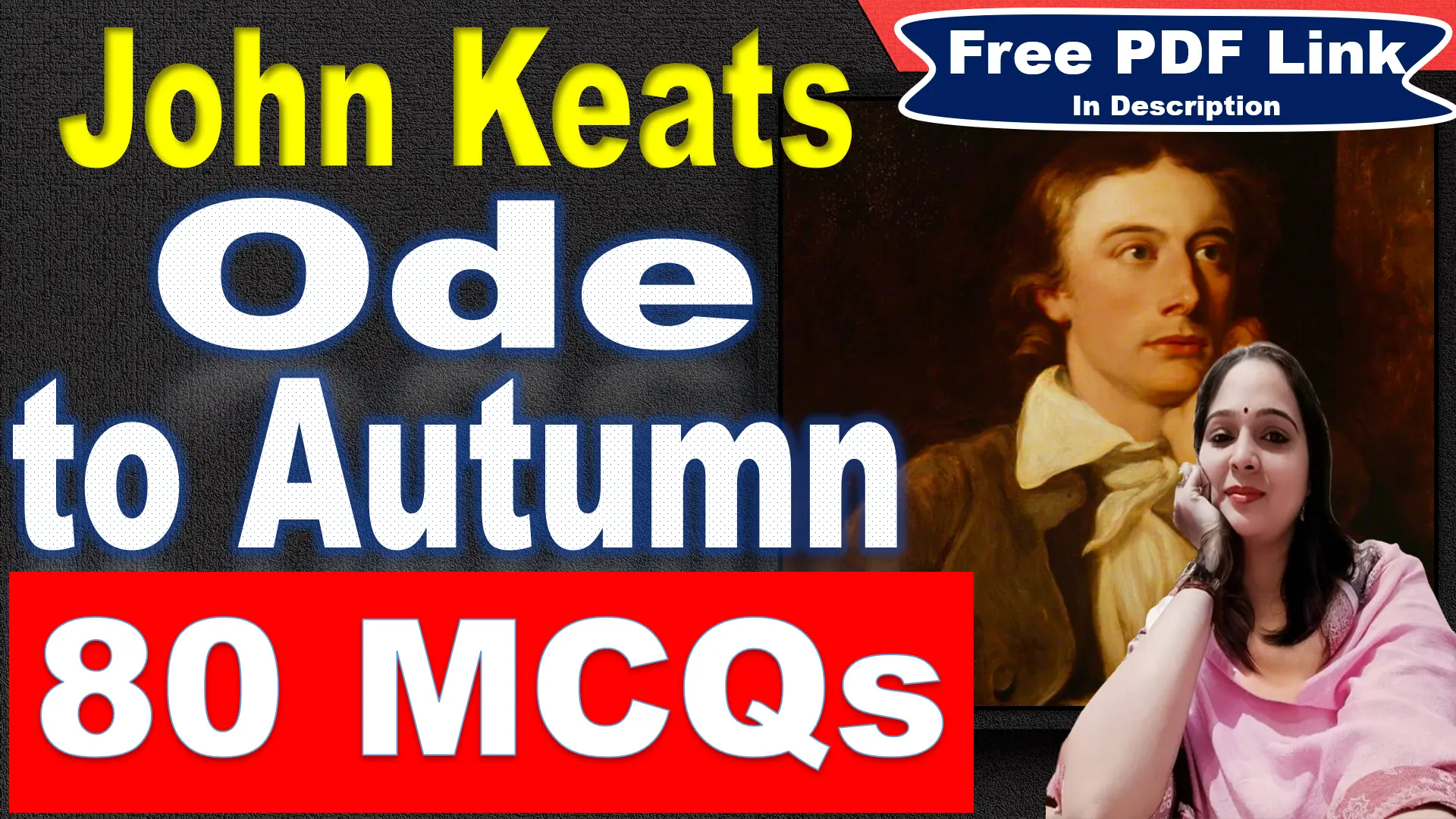
Bright star Poem Questions and Answers
Very Short Answer Questions
Who wrote “Bright Star, would I were stedfast as thou art”?
John Keats wrote the poem.
What is the poem’s main theme?
The main theme is the longing for eternal love and constancy.
To whom or what does the speaker address in the poem?
The speaker addresses a “bright star.”
What quality of the star does the speaker admire?
The speaker admires the star’s constancy and steadfastness.
What does the star symbolize in the poem?
The star symbolizes unchanging permanence.
Does the speaker want to be like the star in every way?
No, the speaker rejects the star’s isolated position.
What does the speaker want instead of isolation?
The speaker wants closeness and intimacy with his beloved.
What metaphor does the speaker use for the waves?
The speaker calls the waves’ motion a “priestlike task” of cleansing.
What natural image follows the mention of the waves?
The image of “soft-fallen” snow on mountains and moors.
What is the rhyme scheme of the poem?
The rhyme scheme is ABABCDCDEFEFGG.
What type of sonnet is “Bright Star”?
It is a Shakespearean sonnet.
Where does the volta, or shift, occur in the poem?
The volta occurs at line 9.
What does the speaker mean by “pillow’d upon my fair love’s ripening breast”?
He longs to be close to his beloved, resting beside her.
What is the speaker’s wish at the end of the poem?
To “live ever” in this closeness or “swoon to death” without it.
What meter is the poem written in?
The poem is written in iambic pentameter.
What poetic device is used in “tender-taken breath”?
Alliteration.
What is the tone of the poem?
The tone is romantic, contemplative, and intense.
What concept does Keats contrast with the star’s isolation?
He contrasts it with the warmth of human intimacy.
What does the speaker consider unbearable in the final line?
Living without his beloved’s closeness.
What feeling does the phrase “sweet unrest” convey?
A sense of constant, passionate awareness in love.
Short Answer Questions
What does the speaker admire about the star, and why does he ultimately reject it?
The speaker admires the star’s constancy and unchanging presence in the sky, symbolizing eternal stability. However, he rejects its isolation, as the star exists alone, detached from human warmth. Instead, he desires a constancy grounded in intimacy, where he can remain close to his beloved rather than be alone and distant like the star.
Explain the significance of the line, “Like nature’s patient, sleepless Eremite.”
By comparing the star to a “sleepless Eremite” or hermit, the speaker highlights the star’s solitude and silent watchfulness over the world. This image of a “patient, sleepless” figure suggests devotion and constancy, but also a lonely separation from human life. It symbolizes a form of steadfastness that the speaker admires but does not want for himself.
How does Keats use the imagery of water and snow in the poem?
Keats uses imagery of “moving waters” performing a “priestlike task” and snow softly covering mountains and moors to depict nature’s constant yet renewing cycles. The water symbolizes purity and cleansing, while the snow suggests a peaceful transformation. These images reflect the beauty and calm of natural cycles, observed by the distant star.
What is the speaker’s ideal form of constancy, as suggested in the poem?
The speaker desires a constancy that is both steadfast and filled with closeness. He wishes to remain beside his beloved forever, feeling her presence and warmth. Unlike the star’s distant constancy, the speaker’s ideal is to be “awake forever in a sweet unrest,” alive with passion and intimacy rather than cold detachment.
What is the rhyme scheme of the poem, and why is it significant?
The poem follows the Shakespearean sonnet rhyme scheme, ABABCDCDEFEFGG. This structured rhyme scheme helps to build a lyrical and contemplative rhythm, adding depth to the speaker’s reflections. The ending couplet provides a resolution, emphasizing the speaker’s intense longing for love over the star’s isolated constancy.
Describe the tone of the poem and how it changes with the volta.
The tone of the poem is initially contemplative and admiring, as the speaker reflects on the star’s constancy. However, with the volta at line 9, the tone shifts to yearning and passionate as he expresses his wish to be steadfast in love. This change reveals the speaker’s preference for intimacy over the star’s lonely permanence.
What does the phrase “sweet unrest” suggest about the speaker’s view of love?
“Sweet unrest” captures the paradox of love as both calming and exciting. For the speaker, true love is not a static, detached feeling; it is an ever-present awareness and connection. This state of “sweet unrest” reflects a longing to remain in the warmth and vibrancy of his beloved’s presence, even if it prevents a tranquil, isolated constancy.
How does Keats use personification in the poem, and what effect does it create?
Keats personifies the star as a watchful, “sleepless” being with “eternal lids apart,” as well as the waters performing a “priestlike task.” This personification gives nature a sense of life and purpose, enhancing the poem’s meditative tone. It allows readers to feel the star’s detached constancy and the waters’ ritual purity, contrasting them with human love and intimacy.
What does the final line reveal about the speaker’s feelings toward love and death?
In the final line, the speaker says he would rather “swoon to death” than live without his beloved’s closeness. This extreme statement reveals the intensity of his emotions, suggesting that life without her would be unbearable. It underscores his belief that a life filled with love and connection is worth living, even if it risks pain or eventual loss.





